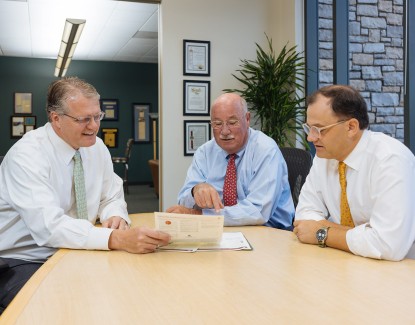The Future Looks Bright for Semiconductor Chips
In their Quarterly Portfolio Update, the Portfolio Managers discuss a new position in Applied Materials, and their decision to exit both Hexcel and Fastenal.
-
 David Rainey, CFACo-Portfolio Manager
David Rainey, CFACo-Portfolio Manager -
 Brian Macauley, CFACo-Portfolio Manager
Brian Macauley, CFACo-Portfolio Manager -
 Ira Rothberg, CFACo-Portfolio Manager
Ira Rothberg, CFACo-Portfolio Manager
New Position: Applied Materials (AMAT)
Applied Materials is a semiconductor capital equipment (semicap) company providing wafer fabrication equipment (WFE) to semiconductor foundries—such as Taiwan Semiconductor Manufacturing Company (TSMC), Intel, and Samsung—for use in the production of semiconductor chips.
Semiconductor chips enable the digital world; they are the basic building blocks of the hardware upon which all software operates. Over the last 20 years, the explosive growth of personal computers, mobile phones, and data centers has fueled semiconductor chip industry growth of nearly 7% per annum. And the future looks similarly bright as technology continues to proliferate and impact our lives in new and unforeseen ways.
The semicap industry is dominated by five companies: Applied Materials, ASML, Lam Research, Tokyo Electron, and KLA. The industry has consolidated meaningfully over time, and today is characterized by high barriers to entry, significant customer switching costs, and rational competition. While there is some overlap in equipment sold, each company has areas it dominates leading to relatively stable market share and attractive economics. This is evidenced by Applied’s roughly 30% operating margin and 40% return on equity.
Manufacturing advanced semiconductors involves over 1,000 steps to create tens of billions of transistors on a chip the size of a fingernail. This isn’t “rocket science,” it is much more difficult! Correspondingly, the equipment to manufacture these chips is incredibly sophisticated, continually pushing the bounds of engineering and physics. Each new generation of WFE is built upon the R&D and proprietary knowhow developed on prior generations of equipment, making it very difficult for a challenger to dislodge a technology leader.
In addition, many of the breakthrough technological advances can only be accomplished through close collaboration between semiconductor foundries and their semicap providers. For the semiconductor foundries, the risk of falling behind on the technology curve by partnering with a second tier semicap provider is too great to bear, further cementing the position of the semicap leaders.
While we like the secular tailwinds and competitive dynamics of the semicap equipment industry, we particularly like how Applied is positioned within the industry.
First, WFE has become more complex and difficult to maintain, repair, and optimize. In addition, recent Applied equipment includes sensors enabling remote monitoring and predictive maintenance. As a result, Applied is now better positioned than customers or third parties to service and repair Applied equipment. The company has been increasing its capture rate of maintenance and service activity, and moving customers from ad hoc service calls to recurring service contracts. We expect these trends to continue, improving the persistency of Applied’s service revenue and driving service revenue growth rates in the low- to mid-teens.
Second, the company has strong product positions in several production steps—such as epitaxial deposition, selective removal, and advanced packaging—that should see above market growth as these solutions play an increasing role in next generation chips.
And third, Applied has the broadest product portfolio in the semicap industry, giving it a presence in each of the key steps of the semiconductor manufacturing process. This portfolio diversifies Applied’s exposure to any particular product step or technology, reducing the overall risk profile of the business. But it also enables an emerging strategic initiative Applied calls Integrated Materials Solution (IMS). Increasingly, Applied is attempting to bundle its equipment across production functions into a single system “under vacuum” to reduce the probability of defects and accelerate a customer’s time to market. Applied is uniquely positioned for IMS, and it provides the company a pathway to gain market share by outflanking competitors offering point solutions.
In combination, we believe these factors should enable Applied to reduce its cyclicality, widen its competitive moat, and gain market share within the semicap equipment industry.
Over the next decade, we expect a continued approximate 7% annual growth rate for the semiconductor chip industry driven by proliferation of mobile phones and data centers as well as emerging demand from 5G, artificial intelligence/machine learning, electric vehicles, and a wide range of IoT and smart devices. We expect that semicap industry growth will closely approximate semiconductor chip industry growth, with Applied producing about 8% or 9% organic revenue growth. We expect this revenue growth, plus modest margin improvement, to drive low double digit operating profit growth. Free cash flow from operations plus sustained financial leverage on growing EBITDA should drive EPS compounding in the mid-teens. Our estimates could prove conservative if national security considerations cause a meaningful shift in semiconductor production out of Taiwan/Asia and into the U.S. and Europe.
We do not expect growth to occur on a smooth path. The semiconductor and semicap industries have been cyclical in the past and we expect them to continue to be cyclical in the future (albeit less so due to the growing diversity of end market applications and a more consolidated customer base better equipped to forecast demand). There are sure to be downturns over the next decade when revenue and earnings temporarily reset lower. However, we are focused on where Applied will be over the long term and are willing to look past the intermediate ups and downs that will be encountered along the way.
Beyond cyclicality, two other key risks we monitor are the growth rate of the semicap equipment industry versus the growth rate of the total semiconductor industry (i.e. the capital intensity of the industry), and the potential for Chinese copycats to replicate Applied’s technology and business. On the first point, the continuously increasing complexity of semiconductor manufacturing and commentary from TSMC and other customers lead us to believe that industry capital intensity should remain relatively flat, or perhaps even increase over the next decade (which is neutral/positive for Applied). Regarding China, the country, and its national champion companies have, despite significant investment and effort, made little progress replicating the capabilities of Applied and the other leading semicap companies. Again, this is very challenging technology, requiring a sophisticated supply chain and close collaboration with customers and others within the industry ecosystem. China cannot simply reverse engineer a piece of capital equipment to leapfrog the decades of development required to get to this point on the technology curve. China has fallen well short of its stated semiconductor capability targets, and our expectation is that it will continue to struggle with little to no direct impact on Applied in the next decade. Nonetheless, it is a strategic focus for China, and therefore bears careful monitoring for a change in conditions. If successful, we expect Chinese semicap equipment adoption would be limited to domestic Chinese foundries. We estimate this market composes approximately 10% of WFE spend.
Exited Positions: Hexcel (HXL) and Fastenal (FAST)
During the quarter, we began selling our position in Hexcel, and completely exited the position shortly after the end of the quarter. We last wrote about Hexcel in our second quarter 2020 letter. At that time the stock was down about 50% from its pre-pandemic highs. As we wrote then, the pandemic hit Hexcel’s business hard, significantly impacting short-term demand. Further, it familiarized the world with Zoom and similar technologies, introducing uncertainty about the long-term demand for business travel. International business travel is often completed with flights on a wide-body aircraft such as the Airbus A350 or Boeing 787 Dreamliner. These aircraft are a key end market for Hexcel, and demand for them would be disproportionately harmed by even a modest reduction in long-term international business travel. In light of those negative developments, we re-underwrote the investment at the then prevailing price and concluded that it offered an attractive five-year rate of return even using conservative expectations about the future.
Since then, the stock rebounded about 45% while the outlook for wide-body aircraft production worsened. As a result, our five-year expected return was no longer compelling and we used Hexcel, in part, as a source of capital for our investment in Applied Materials.
We also sold Fastenal during the quarter. Fastenal is a high-quality business that performed mostly in line with our expectations since our purchase in Q2 2020. However, we concluded that we had better investment opportunities elsewhere so harvested this small position for other uses.
Click here for a full listing of Holdings.
Click here for full, standardized Fund performance.
- In this article:
- Domestic Equity
- Focus Fund
You might also like
-
 Portfolio Perspective
Portfolio Perspective
Focus FundFrom Rate Cuts to AI: Positioning the Portfolio for Potential Opportunity
 David Rainey, CFACo-Portfolio Manager
David Rainey, CFACo-Portfolio Manager Ira Rothberg, CFACo-Portfolio Manager
Ira Rothberg, CFACo-Portfolio Manager Brian Macauley, CFACo-Portfolio ManagerRead the Commentary
Brian Macauley, CFACo-Portfolio ManagerRead the CommentaryThe Portfolio Managers discuss holdings that could potentially benefit from lower rates, tariffs, and artificial intelligence (AI). The team also provides an update on AST SpaceMobile and discusses potential opportunities in select Technology and Health Care companies.
-
 Company Spotlight
Company Spotlight
Focus FundO’Reilly Automotive—Revved for Growth
 David Rainey, CFACo-Portfolio Manager
David Rainey, CFACo-Portfolio Manager Ira Rothberg, CFACo-Portfolio Manager
Ira Rothberg, CFACo-Portfolio Manager Brian Macauley, CFACo-Portfolio ManagerRead the Spotlight
Brian Macauley, CFACo-Portfolio ManagerRead the SpotlightO’Reilly Automotive is a leader in the automotive aftermarket parts industry in the U.S. The company’s scale, unique distribution infrastructure, and customer service-oriented culture should allow it to take market share in a fragmented U.S. market for years to come.
-
 Portfolio Perspective
Portfolio Perspective
Cornerstone Mid Cap 30 FundPortfolio Drivers: Consumer Discretionary and Industrials
 Neil J. HennessyChief Market Strategist and Portfolio Manager
Neil J. HennessyChief Market Strategist and Portfolio Manager Ryan C. Kelley, CFAChief Investment Officer and Portfolio Manager
Ryan C. Kelley, CFAChief Investment Officer and Portfolio Manager L. Joshua Wein, CAIAPortfolio ManagerRead the Commentary
L. Joshua Wein, CAIAPortfolio ManagerRead the CommentaryCornerstone Mid Cap 30 Fund Portfolio Managers Ryan Kelley and Josh Wein review the Fund’s investment strategy, discuss the most recent rebalance, and highlight the recent change in market cap range of potential investments.
